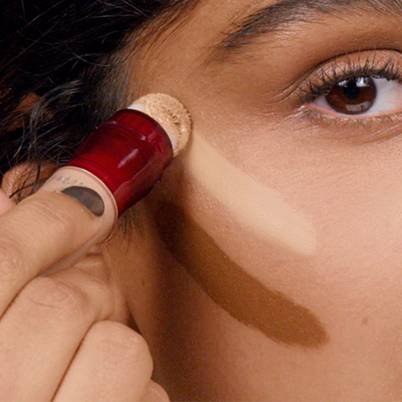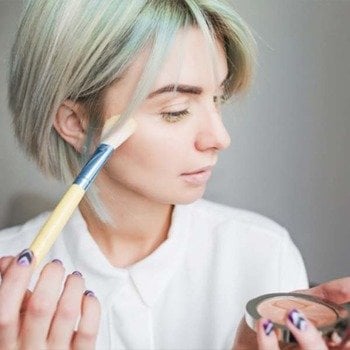A Complete Guide on Using Concealer For Contouring and Highlighting

Some makeup products can do it all. And concealers are one of them! Who would have thought how easy it is to use concealer for contouring or highlighting with concealer? And ever since the makeup enthusiasts learned this trick, using a concealer for highlighting and contouring has become a game changer. Read on as we show you how to do contouring and highlighting with concealer, and more.
How to Use Concealer for Contouring and Highlighting?
Follow the easy step-by-step guide -
- Step 1: Set the Base: Use a primer and foundation to set your base.
- Step 2: Conceal as Usual: Use a concealer to hide any spots, under-eye circles, or blemishes.
- Step 3: Map Your Features: Understand your face structure under natural light.
- Step 4: Choose the Right Shades: Choose lighter shades for highlighting with concealer and dark for contouring.
- Step 5: Highlighting with Concealer: Use a light concealer on the high points of your face
- Step 6: Use Your Concealer for Contouring: Use darker concealers in the hollows of your face.
- Step 7: Blend and Set: Use a setting spray to set your face makeup.
Why Use Concealer for Contouring?
Despite the existence of dedicated face makeup products like highlighters and contours, ever wonder why some makeup artists keep highlighting with concealers? Here are some reasons why -
Lightweight, blendable consistency
Concealers have a luminous, lightweight consistency that may make blending easy for some. Instead of layering multiple cream products, you can work with one familiar formula, just in different tones.
Lightweight Formula
Concealers have a light formula that lets you adjust the kind of makeup look you’re going for, depending on your mood or makeup moment.
Versatile Finish
With both satin and matte finishes, using concealers for contouring lets you sculpt your face softly for everyday wear or build it up for a glamorous look.
Multipurpose Product
Light travel is a great incentive, as using concealer for highlighting and contouring means fewer products in your kit.
Step-by-Step Routine to Use Concealer for Contouring and Highlighting
If you’re ready to experiment with highlighting and contouring using concealers, these simple steps can come in handy -
Step 1: Set the Base
Start with cleansing your face and apply a proper layer of primer. Use a matte primer if you have oily skin and a dewy primer if you have dry, dull skin. Allow it a couple of minutes to set in and follow it with a foundation for a full-face makeup. You can also use a skin tint if you wish to keep things lighter.
Step 2: Conceal as Usual
In the process of doubling concealers as highlights and contours, do not forget their original function. Use your concealers to slightly cover up any areas with pigmentation or uneven tone. Click here to know more on how to apply concealer correctly.
Step 3: Map Your Features
To get started, take a moment to study your face in natural light. Understand where it catches light and where shadows come in. This ensures that you are highlighting and contouring the desired areas. Lightly mark the lines along these high and low points of your face.
Step 4: Choose the Right Shades
Using the same concealer shade for all purposes won’t do. Go two shades lighter while highlighting with concealer and a shade darker when you use concealer for contouring. You can simply borrow your friend’s products if the shade fits. Make sure that your concealers are lightweight, blendable, and long-wear. Make sure you determine your skin undertone before picking a shade.
Step 5: Highlighting with Concealer
Highlighting with concealer helps you accentuate your natural features. It enhances the spots where light naturally falls on your face. Use it under your eyes drawing small, inverted triangles, to amp up your eye makeup. You can also use it along your nose to reflect light, the centre of the forehead to add brightness, a few spots to the chin, and over your cupid’s bow to enhance your lip makeup.
Step 6: Use Your Concealer for Contouring
Using your concealer for contouring helps define our natural face structure. Use it in the hollows of your cheekbones, along the jawline to add sharpness, define the hairline, sides of the nose, and even beneath brow bones to ace eye contouring makeup.
Pro tip: Apply your products with a purpose. Everyone has a different face shape, which is why it is crucial to understand your own bone structure and map out what’s best for you.
Step 7: Blend and Set
Blending is where everything comes together. Use a damp makeup sponge and create gentle upward strokes and a tapping motion to blend the concealers. Lock in your hard work with a long-wear setting spray.
When Do You Use A Concealer For Highlighting And Contouring
A concealer is great for minimal makeup, when you want to look polished, balanced, and subtly lifted. With just two concealers and a blending sponge, you can bring dimension, light, and structure to your features in a way that still feels like you.
Now that you know how to use a concealer for highlighting and contouring, it’s time to get blending. Browse through Maybelline for a variety of lightweight, blendable, longwear makeup products and try the Foundation Finder Tool to get your tone-matched face makeup shade. Follow it up with the Virtual Try-On tool to get your eye and lip makeup picks online.
Looking to up your makeup game by the day? Stay tuned into Maybelline’s face makeup tips.




